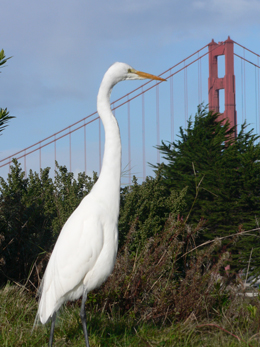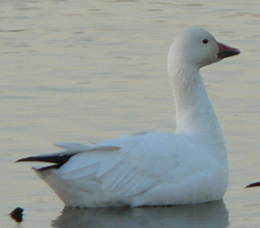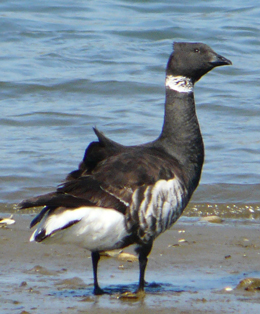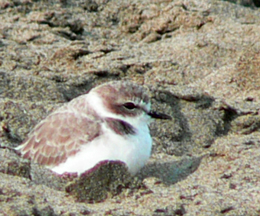April 1, 2010
It never ceases to amaze me that one of the most popular walking spots in the City can support a wide diversity of birds, including endangered species. The Crissy Field Lagoon is a year round pleasure, with different species coming and going throughout the entire year. Since the restoration of the lagoon in 2000, nearly a hundred different species of birds have been found there. Interesting birds also show up during migration on the grassy field that used to be an airstrip, and there's always activity on the ocean side.
.jpg) Recently, I've been going to the Lagoon just after sunrise (7:30 am) to watch a female Belted Kingfisher fish. This beautiful blue bird sits on the bridge that crosses the lagoon and dives repeatedly into the lagoon, coming up with a fish virtually every single time. After swallowing the fish whole, it dives again. Unlike many other bird species, the female Kingfisher is more brightly plumaged than the male, sporting bright rufous feathers that the male lacks. Its rattling call is unmistakable - and usually uttered in flight - this is one bird that is almost always heard before it is seen. Kingfishers nest in burrows on the banks of streams and rivers, and have been known to escape from predators like hawks by diving into water just as the predator is about to catch it.
Recently, I've been going to the Lagoon just after sunrise (7:30 am) to watch a female Belted Kingfisher fish. This beautiful blue bird sits on the bridge that crosses the lagoon and dives repeatedly into the lagoon, coming up with a fish virtually every single time. After swallowing the fish whole, it dives again. Unlike many other bird species, the female Kingfisher is more brightly plumaged than the male, sporting bright rufous feathers that the male lacks. Its rattling call is unmistakable - and usually uttered in flight - this is one bird that is almost always heard before it is seen. Kingfishers nest in burrows on the banks of streams and rivers, and have been known to escape from predators like hawks by diving into water just as the predator is about to catch it.
 Five heron species can be found at Crissy Field, including two Egret species (yes, Egrets are Herons). Egrets were hunted almost to extinction at the beginning of the 20th Century for their splendid plume feathers - used to adorn women's hats. The Audubon Society owes its origin to a campaign to combat the wide scale massacre of these birds - an effort that was ultimately quite successful, and helped save these magnificent birds from being exterminated for vanity.
Five heron species can be found at Crissy Field, including two Egret species (yes, Egrets are Herons). Egrets were hunted almost to extinction at the beginning of the 20th Century for their splendid plume feathers - used to adorn women's hats. The Audubon Society owes its origin to a campaign to combat the wide scale massacre of these birds - an effort that was ultimately quite successful, and helped save these magnificent birds from being exterminated for vanity.
Today three heron species - the Great Blue Heron, the Great Egret and the Snowy Egret - are almost a given at Crissy Field. While both Egrets are white birds, the smaller Snowy Egret has bright yellow feet, and has a black bill, whereas the Great Egret has black feet and a yellow bill. All three are bold birds - I've had a Great Blue Heron land eight feet in front of me at the Lagoon. The last time I visited I also observed two juvenile Black Crowned Night Herons. These nocturnal hunters are more commonly spotted at the nearby Palace of Fine Arts. On rare occasions Green Herons are also spotted at Crissy Field. Green Herons are known to use bait when they fish. They sometimes drop live insects or berries onto the surface of water to attract fish, which then become a meal for the heron. All of these herons nest in trees (with the exception of the Green Heron, which sometimes nests on the ground).
Most people associate geese with the ubiquitous Canada Geese, present in such large numbers that it's hard to believe that they were close to extinction 100 years ago. Conservation programs have been so successful that this goose in now found in every continental U.S. state and every Canadian province, and the annual toll of 2.6 million birds by hunters isn't putting a dent in their numbers (it probably helps that they live a long time - up to 42 years). Canada Geese are often found at Crissy Field, sometimes accompanied by other species of geese. If you see a very small Canada Goose (about the size of a Mallard), it's actually a Cackling Goose, a separate species, essentially identical in plumage to the Canada Goose, but half its size. Before 2004, these small geese were considered a subspecies of Canada Geese, until the American Ornithologist Union decided they were a separate species.

 Four other species of geese can be found at the lagoon, primarily in winter. Two all white geese, the aptly named Snow Goose, and the smaller Ross's Goose, are uncommon visitors. The Ross's Goose was first reported by explorer Samuel Hearne, who spotted them in the Canadian Arctic in 1771 and named them the “Horned Wavey” - the bird was subsequently renamed after Bernard Ross, a Hudson's Bay Company employee in northern Canada. This species is another conservation success story - rebounding from 3,000 in the 1950s to more than 1 million today. They summer in the high Arctic, and spend winters mainly in California. Snow Geese were also called Wavies - which comes from the Chippewa name for this bird - Wewe. During migration they can fly at altitudes of up to 6,600 feet (migrating Canada Geese have been spotted at 9,000 feet). The all time altitude champion, however, can't be found in North America - it's the Bar Headed Goose, which has been spotted at 30,000 feet - flying over the Himalayas.
Four other species of geese can be found at the lagoon, primarily in winter. Two all white geese, the aptly named Snow Goose, and the smaller Ross's Goose, are uncommon visitors. The Ross's Goose was first reported by explorer Samuel Hearne, who spotted them in the Canadian Arctic in 1771 and named them the “Horned Wavey” - the bird was subsequently renamed after Bernard Ross, a Hudson's Bay Company employee in northern Canada. This species is another conservation success story - rebounding from 3,000 in the 1950s to more than 1 million today. They summer in the high Arctic, and spend winters mainly in California. Snow Geese were also called Wavies - which comes from the Chippewa name for this bird - Wewe. During migration they can fly at altitudes of up to 6,600 feet (migrating Canada Geese have been spotted at 9,000 feet). The all time altitude champion, however, can't be found in North America - it's the Bar Headed Goose, which has been spotted at 30,000 feet - flying over the Himalayas.
The Greater White Fronted Goose is found around the globe, being native to Europe, Asia and North America, but it is found mainly west of the Mississippi in the United States, and shows up in small numbers at Crissy Field. Lastly, Brant show up primarily as migrants in the late fall and early spring (there was one that spent three days there in mid-March).
 Many species of shorebirds show up here, but the area is best known for its small population of Snowy Plovers, a species that nests on beaches. Snowy Plovers are considered threatened by the U.S. Wildlife Service. There's a fenced off area for these birds, but unfortunately many dogs still run through the area, threatening an already imperiled species. These birds count on camouflage to protect them, and usually you don't see them until you practically step on them. Young plovers mature quickly - within three hours of hatching, the young leave the nest.
Many species of shorebirds show up here, but the area is best known for its small population of Snowy Plovers, a species that nests on beaches. Snowy Plovers are considered threatened by the U.S. Wildlife Service. There's a fenced off area for these birds, but unfortunately many dogs still run through the area, threatening an already imperiled species. These birds count on camouflage to protect them, and usually you don't see them until you practically step on them. Young plovers mature quickly - within three hours of hatching, the young leave the nest.
© Photos by David Assmann